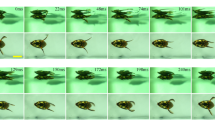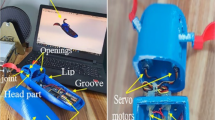Abstract
The exploration of underwater narrow space is of great significance to study the phenomena, process and laws of life in the ocean. The existing underwater robots are not suitable for the underwater narrow area exploration. Beavers use the hind limbs with webfeet to provide power for flexible movement and possess certain underwater operation ability. In this study, based on the bionic prototype of beaver hind limb, the system structure of beaver-like hind limb is designed, and the paddling motion of beaver-like hind limb is realized by combining servos with rope drive. On this basis, the concept of swimming gait is proposed, and swimming process of beavers with one leg and two legs is analyzed, and the movement sequence of various joints and parts in the swimming is studied. Then, the joint angle data of beavers from the video are obtained and a nonlinear oscillation swimming controller based on Fourier technology is proposed to plan the bionic swimming trajectory of the beaver. Further, the swimming efficiency of the beaver-like hind limb is analyzed, and a model of the swimming efficiency is proposed, which can provide a basis for evaluating its swimming effect. Finally, an experimental platform for the swimming of the beaver-like hind limb is set up, and bionic and reconstruction of the swimming gaits are generated by the nonlinear oscillation swimming controller, and the swimming experiment is carried out. The results show that the propulsion efficiencies of the alternate and synchronous bionic gait are 0.5 × 10−3 and 0.6 × 10−3, higher than those of the generated gaits which are 0.2 × 10−3 and 0.3 × 10−3. This verifies the rationality of the beaver swimming, and lays a theoretical foundation for the swimming realization of the beaver-like hind limb, which provides theoretical support for us to further understand the swimming mechanism of the beaver.
Similar content being viewed by others
Explore related subjects
Discover the latest articles, news and stories from top researchers in related subjects.References
Freer, J.J., Tarling, G.A., Collins, M.A., Partridge, J.C., Genner, M.J.: Predicting future distributions of lanternfish, a significant ecological resource within the Southern Ocean. Divers. Distrib. 25(8), 1259–1272 (2019)
Liu, C., Yang, J., Yin, J., An, W.: Coastline detection in SAR images using a hierarchical level set segmentation. IEEE J-Stars. 9(11), 4908–4920 (2016)
Jansen, A., Luck, K.S., Campbell, J., Amor, H.B., Aukes, D.M.: Bio-inspired robot design considering load-bearing and kinematic ontogeny of chelonioidea sea turtles. In: Conference on Biomimetic and Biohybrid Systems, pp. 216–229 (2017)
Packard, G.E., Kukulya, A., Austin, T., Dennett, M., Stokey, R.: Continuous autonomous tracking and imaging of white sharks and basking sharks using a REMUS-100 AUV. In: In 2013 OCEANS-San Diego, pp. 1–5 (2013)
Armstrong, R.A., Pizarro, O., Roman, C.: Underwater robotic technology for imaging mesophotic coral ecosystems. In: Mesophotic Coral Ecosystems, pp. 973–988. Springer (2019)
Zhong, Y., Li, Z., Du, R.: A novel robot fish with wire-driven active body and compliant tail. IEEE/ASME Trans. Mech. 22(4), 1633–1643 (2017)
Shintake, J., Cacucciolo, V., Shea, H., Floreano, D.: Soft biomimetic fish robot made of dielectric elastomer actuators. Soft. Robot. 5(4), 466–474 (2018)
Song, S.H., Kim, M.S., Rodrigue, H.: Turtle mimetic soft robot with two swimming gaits. Bioinspir. Biomim. 11(3), 036010 (2016)
Salumäe, T., Chemori, A., Kruusmaa, M.: Motion control architecture of a 4-fin U-CAT AUV using DOF prioritization. In: 2016 IEEE/RSJ International Conference on Intelligent Robots and Systems (IROS), pp. 1321–1327. IEEE (2016)
Imahama, T., Watanabe, K., Mikuriya, K., Nagai, I.: A method for calculating the amount of movements to estimate the self-position of manta robots. J. Phys. Conf. Ser. 962(1), 012–016 (2018)
Wang, Z., Yu, J., Zhang, A.: Hydrodynamic performance analysis of a biomimetic manta ray underwater glider. In: 2016 IEEE International Conference on Robotics and Biomimetics (ROBIO), pp. 1631–1636. IEEE (2016)
Yu, J., Su, Z., Wu, Z., Tan, M.: Development of a fast-swimming dolphin robot capable of leaping. IEEE-ASME Trans. Mech. 21(5), 2307–2316 (2016)
Yeom, S.-W., Oh, I.-K.: A biomimetic jellyfish robot based on ionic polymer metal composite actuators. Smart Mater. Struct. 18(8), 085002 (2009)
Frame, J., Lopez, N., Curet, O., Engeberg, E.D.: Thrust force characterization of free-swimming soft robotic jellyfish. Bioinspir. Biomim. 13(6), 064001 (2018)
Yu, J., Xiao, J., Li, X., Wang, W.: Towards a miniature self-propelled jellyfish-like swimming robot. Int. J. Adv. Robot. Syst. 13(5), 1729881416666796 (2016)
Rahman, M.M., Sugimori, S., Miki, H., Yamamoto, R., Sanada, Y., Toda, Y.: Braking performance of a biomimetic squid-like underwater robot. J. Bionic. Eng. 10(3), 265–273 (2013)
Kelasidi, E., Liljeback, P., Pettersen, K.Y., Gravdahl, J.T.: Innovation in underwater robots: Biologically inspired swimming snake robots. IEEE Robot. Autom. Mag. 23(1), 44–62 (2016)
Kelasidi, E., Kohl, A.M., Pettersen, K.Y., Hoffmann, B., Gravdahl, J.T.: Experimental investigation of locomotion efficiency and path-following for underwater snake robots with and without a caudal fin. Annu. Rev. Control. 46, 281–294 (2018)
Wang, Z., Gao, Q., Zhao, H.: CPG-inspired locomotion control for a snake robot basing on nonlinear oscillators. J. Intell. Robot. Syst. 85(2), 209–227 (2017)
Herzfeld, M., Schmidt, M., Griffies, S., Liang, Z.: Realistic test cases for limited area ocean modelling. Ocean Model. 37(1–2), 1–34 (2011)
Salazar, M., Little, B.: Rusticle formation on the RMS titanic and the potential influence of oceanography. J. Marit. Archaeol. 12(1), 25–32 (2017)
Mallios, A., Ridao, P., Ribas, D., Carreras, M., Camilli, R.: Toward autonomous exploration in confined underwater environments. J. Field Robot. 33(7), 994–1012 (2016)
Chen, G., Jin, B., Chen, Y.: Accurate and robust body position trajectory tracking of six-legged walking robots with nonsingular terminal sliding mode control method. Appl. Math. Model. 77(1348–1372), 1348–1372 (2020)
Gang, C., Bo, J., Ying, C.: Nonsingular fast terminal sliding mode posture control for six-legged walking robots with redundant actuation. Mechatronics. 50, 1–15 (2018)
Wang, Y., Gu, L., Xu, Y., Cao, X.: Practical tracking control of robot manipulators with continuous fractional-order nonsingular terminal sliding mode. IEEE Trans. Ind. Electron. 6194–6204 (2016)
Wang, Y., Jiang, S., Chen, B., Wu, H.: A new continuous fractional-order nonsingular terminal sliding mode control for cable-driven manipulators. Adv. Eng. Softw. 119(MAY), 21–29 (2018)
Cui, R., Chen, L., Yang, C., Chen, M.: Extended State Observer-Based Integral Sliding Mode Control for an Underwater Robot With Unknown Disturbances and Uncertain Nonlinearities. IEEE Trans. Ind. Electron. 64(8), 6785–6795 (2017)
He, B., Zhou, Y., Wang, Z., Wang, Q., Shen, R., Wu, S.: A multi-layered touch-pressure sensing ionogel material suitable for sensing integrated actuations of soft robots. Sensors Actuators A Phys. 272(341–348), 341–348 (2018)
Guo, J., Li, C., Guo, S.: Path optimization method for the spherical underwater robot in unknown environment. J. Bionic. Eng. 17(5), 944–958 (2020)
Santori, R.T., Vieira, M.V., Rocha-Barbosa, O., Magnan-Neto, J.A., Gobbi, N.: Water absorption of the fur and swimming behavior of semiaquatic and terrestrial oryzomine rodents. J. Mammal. 89(5), 1152–1161 (2008)
Graf, P.M., Wilson, R.P., Sanchez, L.C., Hacklӓnder, K., Rosell, F.: Diving behavior in a free-living, semi-aquatic herbivore, the Eurasian beaver Castor fiber. Ecol. Evol. 8(2), 997–1008 (2018)
Campbell-Palmer, R., Jones, S., Parker, H.: The Eurasian Beaver Handbook: Ecology and Management of Castor Fiber. Pelagic Publishing Ltd. (2016)
Campbell, R.D.: Demography and Life History of the Eurasian Beaver Castor fiber. (2010)
Fish, F.E.: Mechanics, power output and efficiency of the swimming muskrat (Ondatra zibethicus). J. Exp. Biol. 110(1), 183–201 (1984)
Sketching Bird.: Image result for beaver underwater. Available: https: //www.pinterest.com/pin/777152479425265524/ (2021)
European Beaver Photography.: Beaver. Available: https: //www.ingoarndt.com/portfolio/european-beavers/ (2021)
Remi Masson Plongeur Photographe.: Le Castor. Available: https: //www.remimasson.com/gallery/le-castor/ (2021)
Graf, P.M., Mayer, M., Zedrosser, A., Hackländer, K., Rosell, F.: Territory size and age explain movement patterns in the Eurasian beaver. Mamm. Biol. 81(6), 587–594 (2016)
Webb, P.W.: Hydrodynamics and Energetics of Fish Propulsion (1975)
Reynolds, P.S.: Size, shape, and surface area of beaver, Castor canadensis, a semiaquatic mammal. Can. J. Zool. 71(5), 876–882 (1993)
Shipley, E.: The Vertebrate Skeleton, C.J. Clay. Available: https: //www.gutenberg.org/files/43431/43431-h/43431-h.htm (2013). Accessed 9 Aug 2013
Dutch Maritime Productions.: Swimming Beaver-Underwater-Wildlife Rehabilitation. Available: https: //www.youtube.com/watch?v=IUavZJK4FJQ (2019). Accessed 21 May 2019
Jak Wonderly.: Beaver underwater-Bever zwemt onderwater. Available: https: //www.youtube.com/watch?v=04PmnJUfKT4 (2019). Accessed 20 Aug 2019
Zamparo, P., Pendergast, D.R., Termin, B., Minetti, A.E.: How fins affect the economy and efficiency of human swimming. J. Exp. Biol. 205(Pt 17), 2665 (2002)
Zamparo, P., Pendergast, D.R., Mollendorf, J., Termin, A., Minetti, A.E.: An energy balance of front crawl. Eur. J. Appl. Physiol. 94(1–2), 134 (2005)
Tsunokawa, T., Mankyu, H., Takagi, H.: The effect of using paddles on hand propulsive forces and Froude efficiency in arm-stroke-only front-crawl swimming at various velocities. Hum. Mov. Sci. 64, 378–388 (2019)
Acknowledgements
This work was financially supported by National Natural Science Foundation of China (No. 51875528), Zhejiang Provincial Natural Science Foundation of China (No. LY20E050018), and Science Foundation of Zhejiang Sci-Tech University (ZSTU) (No. 17022183-Y).
Author information
Authors and Affiliations
Corresponding author
Additional information
Publisher’s Note
Springer Nature remains neutral with regard to jurisdictional claims in published maps and institutional affiliations.
Rights and permissions
About this article
Cite this article
Chen, G., Ti, X., Shi, L. et al. Design of Beaver-like Hind Limb and Analysis of Two Swimming Gaits for Underwater Narrow Space Exploration. J Intell Robot Syst 104, 65 (2022). https://doi.org/10.1007/s10846-022-01610-7
Received:
Accepted:
Published:
DOI: https://doi.org/10.1007/s10846-022-01610-7




